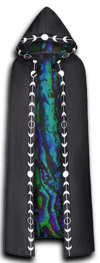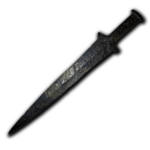Relics & Curiosities: Difference between revisions
Jump to navigation Jump to searchmNo edit summary |
|||
| (7 intermediate revisions by the same user not shown) | |||
| Line 1: | Line 1: | ||
Artifacts are rare, often sought-after items with special powers. The older an item's lineage is the more potential energy it carries and the more effective it may be as ab implement for blood crafts. | Artifacts are rare, often sought-after items with special powers. The older an item's lineage is the more potential energy it carries and the more effective it may be as ab implement for blood crafts. | ||
__TOC__ | |||
__NOEDITSECTION__ | |||
| Line 14: | Line 18: | ||
You can’t just use the item in every ritual, though: it either has to be required in the ritual's ingredients list, or otherwise specifically, magically connected to that ritual. If there’s any doubt in the Storyteller’s mind, it’s not suitable. Of course, items that old have lots of former owners who might haunt them, have cursed them, or even come looking for them... | You can’t just use the item in every ritual, though: it either has to be required in the ritual's ingredients list, or otherwise specifically, magically connected to that ritual. If there’s any doubt in the Storyteller’s mind, it’s not suitable. Of course, items that old have lots of former owners who might haunt them, have cursed them, or even come looking for them... | ||
<br><br> | <br> | ||
<br> | |||
<div style="display:none" class="user-show"> | |||
= '''KNOWN ARTIFACTS''' = | = '''KNOWN ARTIFACTS''' = | ||
| Line 175: | Line 182: | ||
* Tapestry of Blood | * Tapestry of Blood | ||
<br><br> | |||
= '''TOMES & GRIMOIRES''' = | |||
<small>''To emphasize that learning redworking is hard work, define the specific rituals or formulae a given work provides. Some very clear or magically forceful books might speed the learning process from the standard square of the Ritual's Level in weeks: halving it, or reducing it by two-thirds. In addition to blood craft knowledge, many tomes might provide the equivalent of a free Specialty in Occult, or a bonus on a Memoriam pool investigating its revelations. Only the most powerful and versatile of texts should add even one die to Blood Sorcery or Thin- Blood Alchemy pools across the board, although adding one die to specific kinds of rituals, formulae, or wards makes a fair compromise.''</small> | |||
<br><br> | |||
<div class="mw-collapsible mw-collapsed" style="width:568px;"> | |||
<div style="font-weight:bold;line-height:1.6;">Commentary on The Flower of | |||
Hecate</div> | |||
<div class="mw-collapsible-content toccolours"> | |||
''When the Flower was written isn't certain; at first, it seemed to have appeared some time around the 5th century, but earlier references to it crop up now and again. Currently the estimate is sometime around 210 CE. What is certain is that the Flower was a thorough, painstaking exploration of the origins of and the secrets of the craft. Its writing was famously poetic, steeped in mysticism and symbolism. Scholars and magi sought out the Flower not just as a reference book, but as an ultimate ornament for their libraries.'' | |||
<br><br> | |||
''Alas, the last copy was destroyed in 1479. All that remains now are the collected volumes of commentary that accumulated around this text, citing lines and pages lost for hundreds of years. Some lucky rites and rituals have been preserved whole in these commentaries, but they're few and far between. A handful of scholars have devoted themselves to painstakingly reconstructing the original book from these references, trying to fill in the blanks between corrections with research, experience, and just plain guesswork.'' | |||
<br><br> | |||
'''System:''' Referring to a thorough or brilliant version of the Commentary grants one die to the Blood Sorcery pool of one type of ritual (attack, defense, warding, scrying, summoning, transport, elemental energies, those involving werewolves, etc.); essentially a specialty. Writing a thorough or brilliant version of the Commentary— a Project of Scope 1, monthly increments, Launch Roll Occult + Blood Sorcery, Difficulty 3; sorcerers with the Haven Merit Library can add one die to their Launch and Goal rolls— gains the author one dot of Status among Blood sorcerers. | |||
<div style='text-align: right;'> | |||
''<sub>Blood Sigils, pg 144</sub>'' | |||
</div></div></div> | |||
<br> | |||
<div class="mw-collapsible mw-collapsed" style="width:568px;"> | |||
<div style="font-weight:bold;line-height:1.6;">Das Tiefe Geheimnis</div> | |||
<div class="mw-collapsible-content toccolours"> | |||
''This book is probably the most common text on Blood Hermeticism. Written in the 15th century by Johanna Kloepfer, a member of the Cologne chantry, Das Tiefe Geheimnis explains not only the basic tenets of blood sorcery and its history, but also the minutiae and methods of casting many of its most common rituals and workings. Unfortunately for students hoping to find a catch-all textbook, Kloepfer's explanations are full of gaping omissions and strange errors, making her work only useful when read in correlation with other books. But even supplementing just one other book, it reveals a great deal. It's commonly believed that Kloepfer's mistakes weren't careless, but purposefully scattered through the book to make it difficult for a layperson to follow – a common practice among mortal and Kindred philosophers of her day.'' | |||
<br><br> | |||
''Kloepfer originally wrote her book in German, but as the centuries, passed the work was translated into most European languages, titled some variation on The Deep Secret. Almost any library with texts on Blood Sorcery has a copy of this book, translated into their native language. An experienced student of the art may have read the book several times over, and maybe even added to the extensive notes, corrections, and marginalia fellow scholars have added around the pages for five hundred years.'' | |||
<br><br> | |||
'''System:''' As long as the vampire has it available to consult, it grants the Blood Craft specialty to Occult. To discover a new ritual in an annotated copy of Kloepfer, spend a number of nights equal to the ritual's Level studying the book (no hunting) and make an Intelligence + Investigation (Cryptography) test at a Difficulty equal to the ritual's Level plus one. On a critical win, they learn that ritual in two-thirds of the normal time. A sorcerer cannot find more rituals in a given copy of Kloepfer than they have dots in Blood Sorcery. | |||
<div style='text-align: right;'> | |||
''<sub>Blood Sigils, pg 142</sub>'' | |||
</div></div></div> | |||
<br> | |||
<div class="mw-collapsible mw-collapsed" style="width:568px;"> | |||
<div style="font-weight:bold;line-height:1.6;">Experimental Journals of the | |||
Argentinian Circle</div> | |||
<div class="mw-collapsible-content toccolours"> | |||
''The Argentinian Circle was most active during Buenos Aires' 1920s boom, energized by the radical atmosphere whirling around the country. Their tiny group of vampires reasoned that might be an ancient and solemn art, but that didn't mean you couldn't improve on it. Their experiments cost them their unlives when they met their Final Death just outside of the city in an enormous explosion that threw up writhing, radiant columns of white and green fumes.'' | |||
<br><br> | |||
''Only a few copies of their notes survived. The most sought after copy was owned by Ángel Fuchs, a talented Tremere with a reputation as an obsessive thrill-seeker before his Final Death in a BOES dawn raid in 2010. It's not the notes inside the book that intrigue seekers, but the sigil reputedly drawn in a mysterious mixture on the cover that allowed it to somehow survive the conflagration.'' | |||
<br><br> | |||
'''System:''' A chained ritual cast while referring to the Journals pins one Hunger die as a 10 for one caster. The copy with the sigil is completely fireproof; referring to it during casting grants one die to the Blood Sorcery pool of any ritual involving fire, including salamanders (BS, pg. 134). | |||
<div style='text-align: right;'> | |||
''<sub>Blood Sigils, pg 144</sub>'' | |||
</div></div></div> | |||
<br> | |||
<div class="mw-collapsible mw-collapsed" style="width:568px;"> | |||
<div style="font-weight:bold;line-height:1.6;">Katharine Hughart's Book of | |||
Shadows</div> | |||
<div class="mw-collapsible-content toccolours"> | |||
''Katharine Hughart was a 17 year old Wiccan in Vermont who kept a book of shadows in the summer of 1996. Unbeknownst to her, Michael — her boyfriend of a year — had been Embraced just a few months prior, and was planning to Embrace her too. He told Katharine he had learned a magic spell that would grant both of them immortality, and convinced her to carry out a few preparatory rituals with him. Finally, the night of the "immortality spell" came. The rite went horribly wrong, and Katharine was killed — but not before she managed to drive a stake into her boyfriend's heart.'' | |||
<br><br> | |||
''Her book survived, with copious, careful detail of every ritual Michael taught her, complete with sigils and ritual objects…and her growing suspicions about Michael. The final page reads, "If you're seeing this, I'm dead and Michael Leeks is a fucking vampire. Garlic doesn't work." Parties unknown stole her whole Wiccan library from the Brattleboro police evidence locker a week before the FBI's SAD team got there.'' | |||
<br><br> | |||
'''System:''' A ghoul who possesses a copy of Katharine's book and has access to a sorcerer's library can learn one Level 1 Ritual for every dot they have in Occult. To cast those rituals, they still need a dot in Blood Sorcery. | |||
<div style='text-align: right;'> | |||
''<sub>Blood Sigils, pg 145</sub>'' | |||
</div></div></div> | |||
<br> | |||
<div class="mw-collapsible mw-collapsed" style="width:568px;"> | |||
<div style="font-weight:bold;line-height:1.6;">Las Criaturas y El Cuerpo</div> | |||
<div class="mw-collapsible-content toccolours"> | |||
''Fresh off the new discoveries in microbiology of the 19th century, a Madrid chantry member named Ismael Molina published this book in 1889. Molina was obsessed with the idea that bodies were not single entities, but vast and teeming Cities, filled with millions upon millions of bacteria and individual cells. His line of logic led him to the idea that all bodies— Kindred and otherwise— were connected through the invisible sympathies and links that echoed through every cell and bacterium circulating through them.'' | |||
<br><br> | |||
''Molina's book was a wash at publication. Some appreciated it for its detailed descriptions of wards and warding equipment, but most readers brushed off his larger theories as foolish, unwieldy, or simply insane. Only recently, with the emergence of plague oracles (BS, pg. 114), have sorcerers re-examined and even attempted Molina's rituals and rites.'' | |||
<br><br> | |||
'''System:''' Grants one die to Blood Sorcery pools for plague oracle rituals. Contains enough information to develop your own version of Viral Haruspex (for whichever disease you prefer) with an Intelligence + Blood Sorcery test at Difficulty 4. On a critical win, you can learn that ritual in five weeks instead of nine. Readers with the Medicine skill can refer to it while learning any Ward ritual; doing so subtracts their dots in Medicine from the number of weeks it takes to learn the ritual (minimum one week). | |||
<div style='text-align: right;'> | |||
''<sub>Blood Sigils, pg 144</sub>'' | |||
</div></div></div> | |||
<br> | |||
* Das Buch vom Grabkrieg | |||
* Cultes des Goules | |||
* Codex Cæcitus | |||
* Pnakotic Manuscripts | |||
* Cyprianus Notes | |||
* De Vermis Mysteriis | |||
* Revelations of Gla'aki | |||
* Das Kloster | |||
* Book of Eibon | |||
* Unaussprechlichen Kulten | |||
</div> | |||
Latest revision as of 17:18, 9 October 2023
Artifacts are rare, often sought-after items with special powers. The older an item's lineage is the more potential energy it carries and the more effective it may be as ab implement for blood crafts.
System: Distinguishing an actual sorcerous artifact in the wild usually requires Intelligence + Occult against a Difficulty of 2 or higher if the maker intended to conceal its nature. Some such items radiate in spectra perceptible by Auspex.
An item in ritual use for three centuries — not just any 17th-century antique — makes one die in a Ritual or other magical pool as a success: if you have a seven-die pool, flip one of them to a 9 before you roll the other six dice.
- At 600 years of magical use, the item pins two dice as successes.
- At 1,200 years of use, it pins three dice.
- At 2,400 years of use, it pins four dice, and so on.
You can’t just use the item in every ritual, though: it either has to be required in the ritual's ingredients list, or otherwise specifically, magically connected to that ritual. If there’s any doubt in the Storyteller’s mind, it’s not suitable. Of course, items that old have lots of former owners who might haunt them, have cursed them, or even come looking for them...


